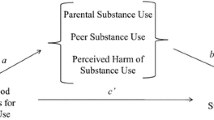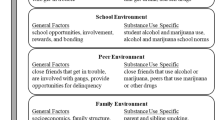Abstract
Prior studies have examined the influence of neighborhood perceptions on youth outcomes, but few studies have examined whose report of neighborhoods, parents’ or youths,’ are most important in predicting youth outcomes. This study addresses the relative associations of youths’ and mothers’ neighborhood perceptions with youth alcohol use and delinquency. The sample includes 499 mother-child dyads (youth age: 10 to 16 [mean=13.3; SD=2]). Structural equation modeling showed that youths’ perceived neighborhood problems were significantly associated with their delinquency but not their alcohol use. However, mothers’ perceived neighborhood problems were not related to either youth alcohol use or delinquency, suggesting that youths’ perceptions are better indicators of youth behavior. Youth reports may reflect their activities in the neighborhood and their exposure to different forms of deviance, so youths’ reports would be better indicators of exposure to neighborhood risk. Challenges for prevention are discussed.


Similar content being viewed by others
References
Avolio BJ, Yammarino FJ, Bass BM (1991) Identifying common methods variance with data collected from a single source: An unresolved sticky issue. J Manag 17(3):571–587
Barry TD, Dunlap ST, Cotton SJ, Lochman JE, Wells KC (2005) The influence of maternal stress and distress on disruptive behavior problems in boys. J Am Acad Child Adolesc Psychiatry 44(3):265–273
Bentler PM (1985–2004) EQS for Windows, 6.1. Multivariate Software, Encino, CA
Briggs XS (1997) Moving up versus moving out: Neighborhood effects in housing mobility programs. Housing Policy Debate 8(1):195–234
Bronfenbrenner U (1992) Ecological systems theory. In: Vasta R (Ed.) Six theories of child development. Jessica Kingsley Publishers, London, pp 187–249
Brooks-Gunn J, Furstenberg FF (1986) The children of adolescent mothers: Physical, academic, and psychological outcomes. Dev Rev 6(3):224–251
Burton LM, Jarrett RL (2000) In the mix, yet on the margins: The place of families in urban neighborhood and child development research. J Marriage Fam 62(4):1114–1135
Burton LM, Price-Spratlen T (1999) Through the eyes of children: An ethnographic perspective on neighborhoods and child development. In: Masten AS (ed) Cultural processes in child development. The minnesota symposia on child psychology. Vol. 29. Lawrence Erlbaum, Mahwah, NJ, pp 77–96
Calvete E, Cardenoso O (2005) Gender differences in cognitive vulnerability to depression and behavior problems in adolescents. J Abnorm Child Psychol 33(2):179–192
Chalder M, Elgar FJ, Bennett P (2006) Drinking and motivations to drink among adolescent children of parents with alcohol problems. Alcohol and Alcoholism 41(1):107–113
Christensen HB, Bilenberg N (2000) Behavioral and emotional problems in children of alcoholic mothers and fathers. Eur Child Adolesc Psychiatry 9:219–226
Datcher L (1982) Effects of community and family background on achievement. The Rev Econ Statist 64(1):32–41.
Donovan JE (2004) Adolescent alcohol initiation: a review of psychosocial risk factors. J Adolesc Health 35(6):529.e7–18.
Doty DH, Glick WH (1998) Common methods bias: Does common methods variance really bias results? Org Res Methods 1(4):374–406
Duncan SC, Duncan TE, Strycker LA (2002) A multilevel analysis of neighborhood context and youth alcohol and drug problems. Prev Sci 3(2):125–133
Elliott DS, Ageton SS, Huizinga D, Knowles BA, Canter RJ (1983) The prevalence and incidence of delinquent behavior: 1976–1980. Behavioral Research Institute, Boulder, CO
Elliott D, Wilson W, Huizinga D, Sampson RJ, Elliott A, Rankin B (1996) The effects of neighborhood disadvantage on adolescent development. J Res Crime Del 33(4):389–426
Ennett ST, Flewelling RL, Lindrooth RC, Norton EC (1997) School and neighborhood characteristics associated with school rates of alcohol, cigarette, and marijuana use. J Health Soc Behav 38(1):55–71
Feinberg M, Neiderhiser J, Howe G, Hetherington EM (2001) Adolescent, parent, and observer perceptions of parenting: Genetic and environmental influences on shared and distinct perceptions. Child Dev 72(4):1266–1284
Geckova A, van Dijk JP, Groothoff JW, Post D (2002) Socio-economic differences in health risk behaviour and attitudes towards health risk behaviour among Slovak adolescents. Soc Prev Med 47(4):233–239
Grant KE, O’Koon JH, Davis TH, Roache NA, Poindexter LM, Armstrong ML, Minden JA, McIntosh JM (2000) Protective factors affecting low-income urban African American youth exposed to stress. J Early Adolesc 20(4):388–417
Hartos JL, Power TG (1997) Mothers’ awareness of their early adolescents’ stressors: Relation between awareness and adolescent adjustment. J Early Adolesc 17(4):371–389
Howard DE, Cross SI, Li X, Huang W (1999) Parent-youth concordance regarding violence exposure: Relationship to youth psychosocial functioning. J Adolesc Health 25(6):396–406
Hu L, Bentler PM (1999) Cutoff criteria for fit indexes in covariance structure analysis: Conventional criteria versus new alternatives. Struct Equ Model 6(1):1–55
Iguchi MY, Bell J, Ramchand RN, Fain T (2005) How criminal system racial disparities may translate into health disparities. J Health Care Poor Underserved 16(4 Suppl B):48–56
Jessor R, Van Den Bos J, Vanderryn J, Costa FM, Turbin MS (1995) Protective factors in adolescent problem behavior: Moderator effects and developmental change. Dev Psychol 31(6):923–933
Johnston CA, Steele RG, Herrera EA, Phipps S (2003) Parent and child reporting of negative life events: Discrepancy and agreement across pediatric samples. J Pediatr Psychol 28(8):579–588
Karvonen S, Rimpela A (1996) Socio-regional context as a determinant of adolescents’ health behaviour in Finland. Soc Sci Med 43(10):1467–1474
Kling J, Liebman J, Katz L (2005) Bullets don’t got no name: Consequences of fear in the ghetto. In: Weisner TS (ed) Discovering successful pathways in children’s development: mixed methods in the study of childhood and family life. University of Chicago, pp 243–281
Lambert SF, Brown TL, Phillips CM, Ialongo NS (2004) The relationship between perceptions of neighborhood characteristics and substance use among urban African American adolescents. Am J Commun Psychol 34(3–4):205–218
Lerman P (1967) Argot, symbolic deviance and subcultural delinquency. Am Sociol Rev 32(2):209–224
Leventhal T, Brooks-Gunn J (2000) The neighborhoods they live in: the effects of neighborhood residence on child and adolescent outcomes. Psychol Bull 126(2):309–337
Miller BA (2004) Alcohol and drug use among adolescent offspring of alcoholic women in treatment: The role of mothers’ punitive and protective behaviors. Paper presented at the 27th Annual Meeting of the Research Society on Alcoholism, Vancouver, B.C., Canada. June 26–30, 2004
Neumark-Sztainer D, Story M, French S, Cassuto N, Jacobs DR, Jr, Resnick MD (1996) Patterns of health-compromising behaviors among Minnesota adolescents: Sociodemographic variations. Am J Public Health 86(11):1599–1606
Office of Applied Studies, Substance Abuse and Mental Health Services Administration (SAMHSA). (1997, March). National Household Survey on Drug Abuse: Main findings 1995 (DHHS Publication No. SMA 97-3127). Rockville, MD: Author
Parker JS, Benson MJ (2004) Parent-adolescent relations and adolescent functioning: Self-esteem, substance abuse, and delinquency. Adolescence 39(155):519–530
Patterson GR, Stouthamer-Loeber M (1984) The correlation of family management practices and delinquency. Child Dev 55(4):1299–1307
Peeples F, Loeber R (1994) Do individual factors and neighborhood context explain ethnic differences in juvenile delinquency? J Quant Criminol 10(2):141–157
Plybon LE, Edwards L, Butler D, Belgrave FZ, Allison KW (2003) Examining the link between neighborhood cohesion and school outcomes: The role of support coping among African-American adolescent girls. J Black Psychol 29(4):393–407
Rankin BH, Quane JM (2002) Social contexts and urban adolescent outcomes: The interrelated effects of neighborhoods, families, and peers on African-American youth. Soc Probl 49(1), 79–100
Reifman A, Barnes GB, Dintcheff BA, Farrell MP, Uhteg L (1998) Parental and peer influences on the onset of heavier drinking among adolescents. J Stud Alcohol 59:311–317
Russell M (1995) TWEAK: Medical Outcomes Trust. In: Allen JP, Columbus M (eds) Assessing alcohol problems: A guide for clinicians and researchers. National Institute on Alcohol and Alcoholism, Bethesda, MD, pp 540–545
Sampson RJ, Lauritsen JL (1994) Violent victimization and offending: individual, situational-, and community-level risk factors. In: Reiss AJ, Jr, Roth JA (eds) Understanding and preventing violence, Vol 3: Social influences. National Academy Press, Washington, DC, pp 1–114
Sampson RJ, Raudenbush SW (2004) Seeing disorder: Neighborhood stigma and the social construction of “Broken Windows.” Soc Psychol Q 67(4):319–342
Sampson RJ, Raudenbush SW, Earls F (1997) Neighborhoods and violent crime: A multilevel study of collective efficacy. Science 277:918–924
Scheier LM, Botvin GJ, Miller NL (1999) Life events, neighborhood stress, psychosocial functioning, and alcohol use among urban minority youth. J Child Adolesc Subst Abuse 9(1):19–50
Shaw CR, McKay HD (1942) Juvenile delinquency and urban areas. University of Chicago Press, Chicago
Shumow L, Vandell DL, Posner J (1998) Perceptions of danger: A psychological mediator of neighborhood demographic characteristics. Am J Orthopsychiatry 68(3):468–478
Sobell LC, Maisto SA, Sobell MB, Cooper AM (1979). Reliability of alcohol abusers’ self-reports of drinking behavior. Behav Res Ther 17(2), 157–160.
Sobell LC, Sobell MB (1992) Timeline Follow-Back: A technique for assessing self-reported alcohol consumption. In: Litten R, Allen J (eds) Measuring alcohol consumption: psychosocial and biochemical methods. The Humana Press Inc, Totowa, NJ, pp 41–72
Sobell MB, Sobell LC (1996) Problem drinkers: Guided self-change treatment. Guilford Press, New York
Substance Abuse and Mental Health Services Administration (SAMHSA). (2005) Results from the 2004 National Survey on Drug Use and Health: National Findings (Office of Applied Studies, NSDUH Series H-28, DHHS Publication No. SMA 05-4062). Rockville, MD
Taylor J, Malone S, Iacono WG, McGue M (2002) Development of substance dependence in two delinquency subgroups and nondelinquents from a male twin sample. J Am Acad Child Adolesc Psychiatry 41(4):386–393
van den Bree MBM, Pickworth WB (2005) Risk factors predicting changes in marijuana involvement in teenagers. Arch Gen Psychiatry 62:311–319
Vega WA, Zimmerman RS, Warheit GJ, Apospori E, Gil AG (1993) Risk factors for early adolescent drug use in four ethnic and racial groups. Am J Public Health 83(2):185–189
Will JA, McGrath JH (1995) Crime, neighborhood perceptions, and the underclass: The relationship between fear of crime and class position. J Criminal Justice 23(2):163–176
Acknowledgments
We thank the reviewers for their helpful comments. Thanks are also extended to Joel Grube for his statistical guidance. Research for and preparation of this manuscript were supported by NIAAA “Mother’s Alcohol Problems and Children’s Victimization” R01 AA0755409, 1998–2002, Brenda A. Miller, PI and NIAAA “Prevention Science Research Training Program Grant” T32 AA014125, 2004-2009, Genevieve Ames, PI.
Author information
Authors and Affiliations
Corresponding author
Additional information
NIAAA Postdoctoral Fellow and Associate Research Scientist at the School of Public Health, University of California, Berkeley, and the Prevention Research Center, Pacific Institute for Research and Evaluation, Berkeley, CA. Her research interests include psychosocial and environmental factors influencing youth problem behaviors.
Interests are interventions for children with substance use or externalizing problems and their families.
She is currently conducting alcohol, drug and other risky behavior prevention studies that include a focus on young adults in club settings as well as a variety of different family-based studies in different geographic regions (San Francisco Bay Area, Alaska, Thailand).
Her work integrates both quantitative and qualitative research methods and centers on alcohol and other drug use, and related health issues among adolescents and young adults. She is especially interested in applying theoretical models of socially learned behaviors to populations with different cultural and social backgrounds
Rights and permissions
About this article
Cite this article
Byrnes, H.F., Chen, MJ., Miller, B.A. et al. The Relative Importance of Mothers’ and Youths’ Neighborhood Perceptions for Youth Alcohol Use and Delinquency. J Youth Adolescence 36, 649–659 (2007). https://doi.org/10.1007/s10964-006-9154-2
Received:
Accepted:
Published:
Issue Date:
DOI: https://doi.org/10.1007/s10964-006-9154-2




